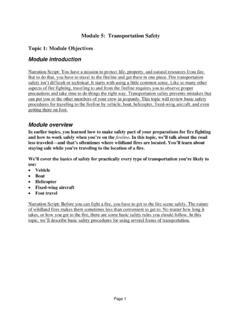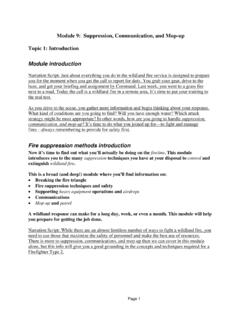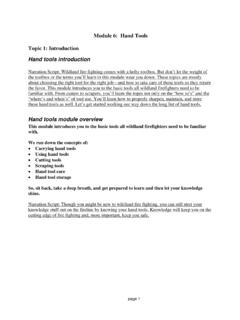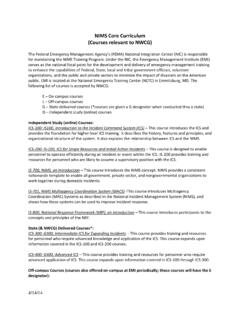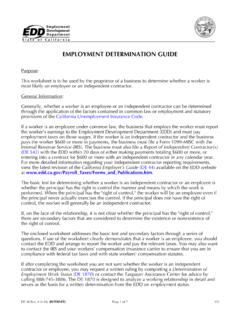Transcription of Principles of wildland fire behavior introduction - NWCG
1 Module 2: Principles of wildland fire behavior Topic 1: introduction Principles of wildland fire behavior introduction Narration Script: Preparation is a key component in effective fire fighting and it's more than your gear and equipment that need attention your mental preparation is just as important. Before setting out, you should be fully briefed on the types of terrain you'll encounter, including any obstacles and helpful barriers. You'll need detailed weather reports describing both current conditions and expected forecasts. You'll also want to study the surrounding area to gain a firm understanding of existing fuel types. Once you have the lay of the land, (and air for that matter,).
2 You will have a strong grasp on how each of these factors can affect the fire 's behavior . Conditions can change quickly, so stay sharp and stay informed. Module introduction As your experience on the fireline grows, you'll realize that it doesn't take much for a wildland fire to grow out of control, especially if factors influencing the fire go undetected. Like links in a chain, individual factors influencing fire behavior acquire strength when working together. As you'll discover, topography, fuel, and weather are the main culprits to watch. Your grasp of environmental factors will help you manage the fire and reduce potential property loss and more important maintain the safety of you and the crew.
3 Sit back and take a good hold on your mouse, and actively dive into this module as it introduces you to factors influencing fire behavior including: Topography Fuels Weather Narration Script: Weather makes firefighters work harder: Dry fuel Eight blazes in Oregon and Washington continue to burn, and lightning may bring more! This headline was noted in a recent edition of the The Oregonian Newspaper. This typical wildfire headline illustrates the impact that fuel conditions and weather can have on any wildland fire . If you become skilled in identifying and evaluating conditions and recognizing how topography, fuels, and the weather can affect fire behavior , you will be a key player in successful wildland fire management efforts.
4 This module will deepen your understanding of wildland fire behavior and the factors that can affect it. Page 1. Topic 2: Topography Topography introduction You'd be hard pressed to find a more physically demanding job than wildland firefighter. But as you'll learn very quickly in your career, part of the job description is to be a keen observer. With experience, training, and study, you'll begin to understand the role of the many factors affecting fire behavior . In this topic, we spotlight topography's effect on a fire and specifically discuss the following topographic elements including: Aspect Slope Canyons and terrain Barriers Keep reading to get the lay of the land of this topic.
5 Narration Script: As your knowledge of wildland fire fighting increases with long hours in the field and even longer ones hitting the books you'll come to realize that your mind is as much a tool in wildfire management as your muscles. A fire 's behavior isn't completely predictable, but there are well-studied factors affecting a fire 's behavior you will learn to identify that will give you one heck of an indication of how to approach the situation. In this topic, we turn your attention to topography and how the so-called lay of the land can help you understand how a fire behaves. Topography Firefighters wear a lot of hats. One of them is detective. Let's get down and dirty and talk about the clues the terrain provides.
6 You can lump terms like scenery, landscape, geography, and countryside under the umbrella of topography. No matter the name, the general features of the earth's surface have a tremendous impact on the way a wildland fire behaves. Local topography affects a fire 's: Intensity Rate and the direction of spread Narration Script: Topography is essentially the terrain of the land but includes man-made structures. Topography or Terrain includes the shape of the landscape, its elevation, steepness, the slope, and the direction that slopes face, which is known as the aspect.. Topography can be friend or foe on the fireline. As you gain experience using topographic maps and compasses, you'll begin to read and interpret the landscape and how it can affect fire behavior .
7 Topography is the third largest factor in wildland fire fighting, with fuels and weather leading the pack but the good news is that topography is far more predictable than the wind! Page 2. Topography's influencing factors Reading the landscape is another tool we'll touch on shortly especially to uncover the dangers of wind channeling elements in steep terrain. Before that, let's look into the fundamentals of topography. There are two influential topographic features you need to especially concern yourself with because of their influence on wildland fire behavior . They are: Aspect Slope You will investigate each of these features in turn to learn more about their impact on wildland fires.
8 Aspect A slope's aspect is the compass direction the slope faces. This includes: North East West South The aspect of a slope determines the effect of the sun's heat on the slope's plants and trees, air temperature, and moisture retention of the soil. Solar radiant heating can influence fire behavior by influencing fuel moisture and ignition points. Read the following to get to the point about slope faces. North Facing Slopes North facing slopes tend to have more shade. As a result, north facing slopes have heavier fuels, lower temperatures, higher humidity, and higher fuel moistures. A north facing aspect will have less fire activity than a south facing slope.
9 East Facing Slopes Eastern and southeastern slope exposures have about equal solar heating as the sun moves across the sky from east to west. With sunrise, east facing slopes will have earlier heating, but also earlier cooling as the sun tracks across the sky. West Facing Slopes Similar to eastern and southeastern slopes, southwestern, and western slope exposures have about equal solar heating as the sun moves across the sky from east to west. West facing slopes will have later heating and cooling during the course of the day. Page 3. South Facing Slopes In the Northern Hemisphere, the slopes facing south receive direct sun rays and become hotter than the slopes facing any other direction.
10 The higher temperature on the southern exposures results in lower humidity, rapid loss of fuel and soil moisture, and drier, lighter flashy fuels such as grass. All of these things add together to make southern slopes more susceptible to fires than northern slopes. Slope Slope relates to the incline of any land mass whether it's natural or built by human hands (like a reservoir or the sides of a dam). In the absence of winds, fires usually move faster uphill than downhill, so the steeper the slope, the faster a fire moves. The increased rate of spread (ROS) is due to several factors: Uphill side of a fire Flames are closer to the fuel dehydrating, preheating, and igniting them sooner than they would if they were on level ground.
